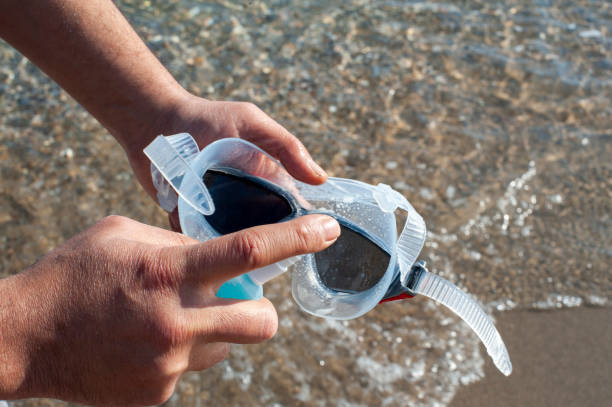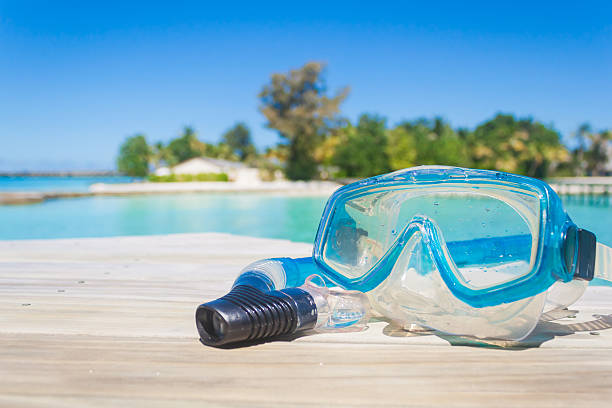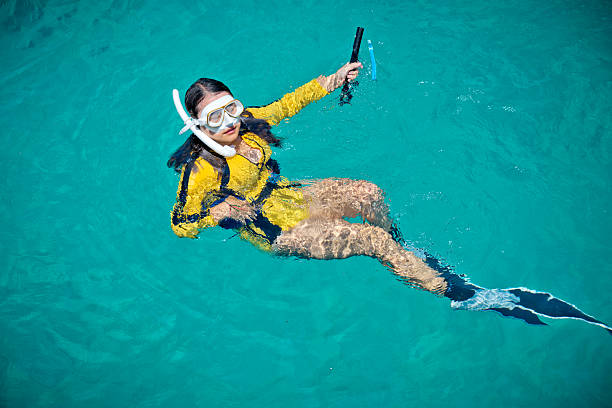Lorsque vous explorez le monde sous-marin, les palmes de snorkeling sont vos fidèles compagnons. Cet équipement essentiel vous offre la propulsion nécessaire pour glisser sans effort dans l'eau. Comprendre ce que sont les palmes de snorkeling et leur importance est crucial pour tout plongeur. Qu'il s'agisse d'améliorer votre mobilité ou de conserver votre énergie, ces palmes jouent un rôle essentiel dans vos aventures aquatiques. Explorons ensemble les palmes de snorkeling et décrivons brièvement les différents types disponibles.
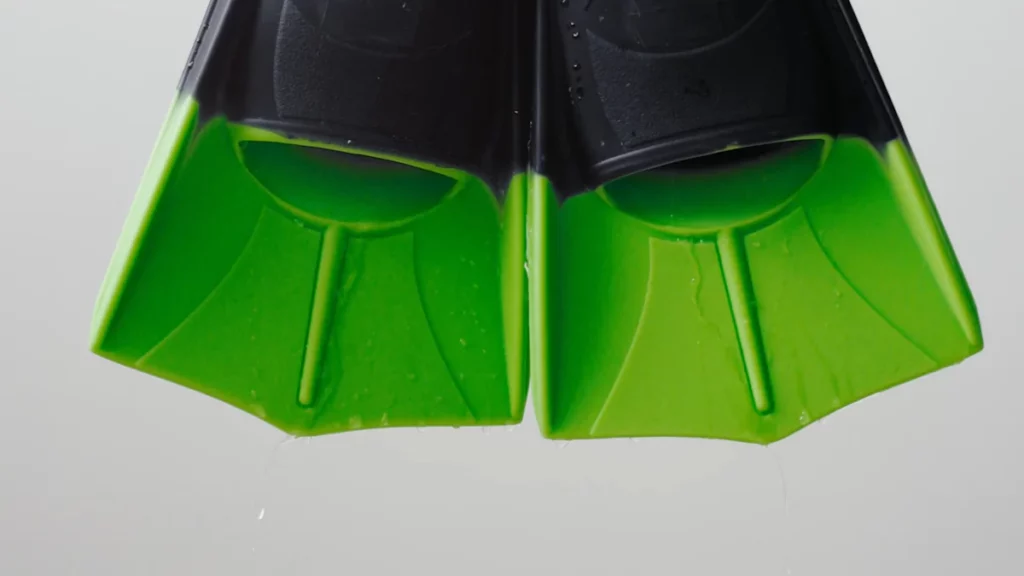
Qu'est-ce que les palmes de snorkeling ?
Palmes de plongée en apnéeIndispensables à toute aventure de snorkeling, les palmes améliorent la propulsion et la maniabilité du nageur. Elles réduisent l'effort nécessaire pour se déplacer, permettant aux plongeurs de glisser en douceur et efficacement. Conçues avec expertise et disponibles en différents styles (chaussantes ou ouvertes), ces palmes s'adaptent à différentes conditions d'eau et à vos préférences personnelles. En amplifiant la puissance des jambes et en offrant un meilleur contrôle, les palmes de snorkeling rendent l'expérience plus agréable et permettent d'économiser l'énergie, ce qui les rend indispensables pour les plongeurs débutants comme expérimentés.
Types de palmes de plongée en apnée
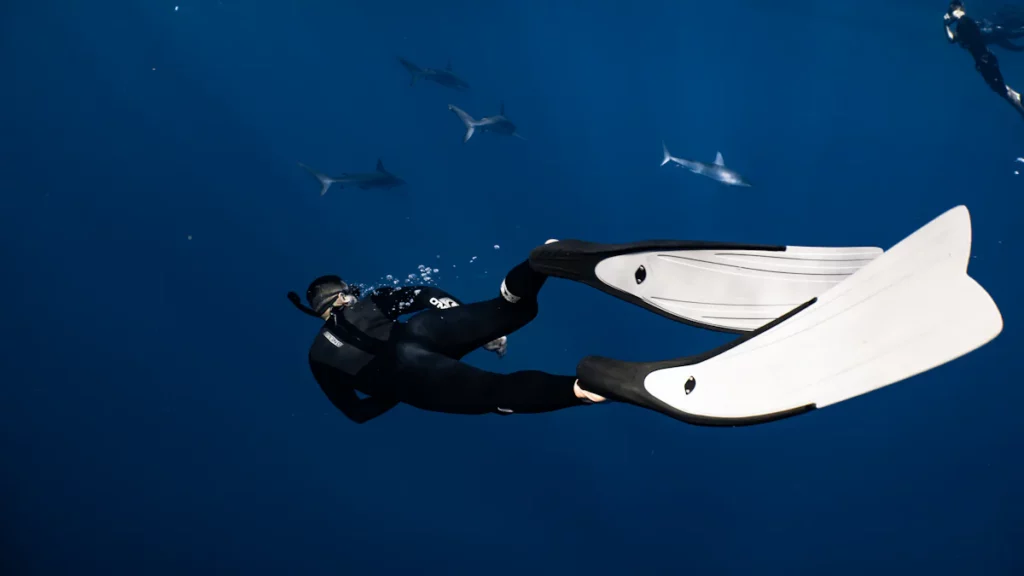
Pour choisir le meilleur type de palmes pour le snorkeling, il est essentiel de comprendre les différentes options disponibles. Chaque modèle répond à des préférences et des conditions variées, et chacun présente des avantages et des inconvénients spécifiques. Voici un aperçu des principaux types de palmes de snorkeling pour vous aider à faire un choix éclairé.
Palmes chaussantes
Les palmes chaussantes sont des équipements de snorkeling conçus pour couvrir l'intégralité du pied, offrant un maintien sûr et confortable. Apparues au milieu du XXe siècle, ces palmes ont révolutionné la propulsion sous-marine en améliorant l'efficacité de la nage. Fabriquées à partir de matériaux légers comme le caoutchouc ou le silicone, elles sont idéales pour les eaux chaudes. Leur facilité d'utilisation et leur portabilité les rendent populaires auprès des snorkeleurs occasionnels et des débutants, offrant un moyen pratique et efficace de naviguer en milieu sous-marin sans chaussures supplémentaires comme des chaussons.
Avantages des palmes chaussantes :
- Facile à mettre et à enlever
- Léger et compact, idéal pour les voyages
- Ajustement confortable sans avoir besoin d'équipement supplémentaire comme des chaussons
Inconvénients des palmes chaussantes:
- Ajustement de taille limité, peut ne pas convenir parfaitement à tout le monde
- Moins de protection contre l'eau froide et les surfaces rugueuses
- Pas idéal pour un port prolongé dans des conditions plus froides
Qui va utiliser
Les plongeurs occasionnels dans les eaux chaudes et tropicales apprécieront la praticité et le confort des palmes chaussantes. Elles sont parfaites pour les débutants grâce à leur simplicité et leur facilité d'utilisation. Les voyageurs privilégient souvent les palmes chaussantes pour leur légèreté et leur portabilité, ce qui en fait un excellent choix pour les aventures de snorkeling en vacances.
Palmes à talon ouvert
Les palmes à talon ouvert sont des équipements de plongée et de snorkeling dotés de sangles réglables laissant le talon exposé. Ce design permet un ajustement personnalisé et l'utilisation de chaussons en néoprène pour plus de chaleur et de protection. Apparues au milieu du XXe siècle, avec les progrès de la technologie de plongée, ces palmes sont idéales pour diverses conditions aquatiques, y compris les environnements froids. Fabriquées à partir de matériaux durables comme le caoutchouc et le plastique, elles offrent polyvalence et confort, ce qui en fait un modèle de prédilection pour les snorkeleurs et les plongeurs expérimentés qui recherchent adaptabilité et performance dans divers environnements aquatiques.
Avantages des palmes à talon ouvert :
- Bretelles réglables pour un ajustement personnalisable
- Peut être porté avec des chaussons en néoprène pour plus de chaleur et de protection
- Convient à une variété de températures et de conditions d'eau
Inconvénients des palmes à talon ouvert:
- Plus lourd et plus volumineux, ce qui peut être moins pratique pour les voyages
- Les sangles peuvent s'user et nécessiter un remplacement
- Légèrement plus complexe à mettre et à enlever que les palmes chaussantes
Qui va utiliser
Les palmes à talon ouvert sont idéales pour les snorkeleurs qui fréquentent les eaux plus fraîches ou les conditions variables, car elles peuvent être associées à des chaussons pour plus de chaleur. Les snorkeleurs et plongeurs expérimentés qui recherchent un ajustement précis et une polyvalence avantageuse trouveront ces palmes avantageuses. Elles conviennent également à ceux qui préfèrent un équipement plus ajustable et personnalisable.
ailerons fendus
Les palmes fendues sont des palmes de plongée et de snorkeling avancées, dotées d'une fente unique au milieu de la voilure, conçue pour réduire la traînée et accroître l'efficacité. Développées à la fin du XXe siècle, elles ont révolutionné la propulsion sous-marine en imitant le mouvement des animaux marins. Ces palmes sont généralement fabriquées en caoutchouc ou en matériaux composites de haute qualité, offrant une vitesse accrue et réduisant la fatigue des jambes. Idéales pour les plongeurs expérimentés, les meilleures palmes fendues pour le snorkeling offrent des performances et un confort supérieurs, rendant les longues sessions sous-marines moins fatigantes et plus agréables.
Avantages des ailerons fendus :
- La conception unique réduit la traînée et augmente l'efficacité
- Moins de tension sur les jambes, ce qui les rend idéales pour les séances plus longues
- Peut améliorer la vitesse avec moins d'effort
Inconvénients des ailerons fendus :
- Peut être plus cher que les palmes traditionnelles
- Peut nécessiter une période d'adaptation pour les nouveaux utilisateurs
- Pas aussi efficace pour les coups de pied puissants dans les courants forts
Qui va utiliser
Les snorkeleurs qui privilégient l'efficacité et la réduction de la fatigue des jambes bénéficieront des palmes fendues. Ces palmes sont idéales pour les snorkeleurs expérimentés en quête d'amélioration de leurs performances et pour ceux qui souhaitent investir dans un équipement sophistiqué pour une expérience plus agréable. Elles sont particulièrement appréciées des snorkeleurs qui pratiquent des sessions prolongées et souhaitent minimiser la tension sur leurs jambes.
Palmes de pagaie
Les palmes paddle sont des palmes robustes pour la plongée avec tuba et le snorkeling, caractérisées par une voilure solide et insécable. Développées au milieu du XXe siècle, ces palmes sont réputées pour leur puissance et leur capacité de propulsion, ce qui les rend adaptées aux courants forts et aux conditions sous-marines difficiles. Généralement fabriquées à partir de matériaux durables comme la fibre de verre ou le plastique de haute qualité, les palmes paddle offrent une durabilité et des performances exceptionnelles. Elles fournissent une poussée efficace à chaque battement, permettant aux plongeurs de naviguer rapidement dans les eaux. Les palmes paddle sont plébiscitées par les plongeurs en quête de puissance et de contrôle maximum lors de leurs aventures sous-marines.
Avantages des palmes à pagaie
- Propulsion améliorée : La grande taille de la lame des palmes Paddle Fins se traduit par des coups de pied puissants, vous propulsant dans l'eau sans effort.
- Versatilité: Adaptées aussi bien aux débutants qu'aux plongeurs expérimentés, ces palmes s'adaptent bien à différents styles de nage.
- Durabilité: Fabriquées à partir de matériaux de haute qualité, les palmes Paddle offrent des performances durables même dans des conditions difficiles.
Inconvénients des palmes à pagaie
- Poids: En raison de leur construction robuste, les palmes Paddle peuvent sembler plus lourdes que les autres types de palmes, nécessitant plus d'efforts lors d'une utilisation prolongée.
- Flottabilité: La plus grande surface des lames peut entraîner une flottabilité accrue, affectant votre contrôle de la profondeur pendant la plongée ou la plongée avec tuba.
Qui va utiliser
Les snorkeleurs qui privilégient la puissance et l'efficacité lors de leurs excursions sous-marines bénéficieront pleinement des palmes Paddle. Que vous exploriez des récifs coralliens luxuriants ou que vous naviguiez au milieu de la vie marine en pleine mer, ces palmes offrent la poussée nécessaire pour une expérience de snorkeling agréable.
Quelle est la différence entre les palmes de plongée et les palmes de natation ?
Pour comparer les palmes de snorkeling et les palmes de natation, il est essentiel de comprendre leurs fonctions spécifiques dans les activités aquatiques. Voici un tableau comparatif entre les palmes de snorkeling et les palmes de natation.
| Fonctionnalité | Palmes de plongée en apnée | Palmes de natation |
| Conception | Lames plus longues et plus larges | Lames plus courtes et plus compactes |
| But | Améliorer la propulsion et la maniabilité sous l'eau | Améliorer la technique de nage et la force des jambes |
| Rigidité de la lame | Généralement plus rigide pour une poussée plus forte | Plus flexible pour permettre un mouvement de coup de pied naturel |
| Couverture des pieds | Disponible en modèles à pied complet et à talon ouvert | Conception généralement à pied complet |
| Conditions de l'eau | Convient à diverses conditions d'eau, y compris l'eau libre | Principalement utilisé dans les piscines ou les environnements d'eau calme |
| Durée d'utilisation | Conçu pour une utilisation prolongée en snorkeling | Conçu pour les entraînements de courte durée et de haute intensité |
| Efficacité | Maximise l'efficacité dans l'eau, réduit la fatigue | Se concentre sur l'amélioration de la forme et de la vitesse du nageur |
| Matériels | Fabriqué à partir de matériaux durables comme le caoutchouc et le silicone | Souvent fabriqué à partir de caoutchouc plus souple et léger |
| Ajustabilité | Les versions à talon ouvert offrent un réglage avec des sangles | Ajustabilité limitée, conception généralement monobloc |
| Équipement supplémentaire | Peut être utilisé avec des chaussons (palmes à talon ouvert) | Généralement utilisé sans équipement supplémentaire |
| Utilisateurs cibles | Plongeurs en apnée et sous-marine | Nageurs, entraîneurs de natation, passionnés de fitness |
| Accent sur la performance | Donne la priorité au contrôle et à l'efficacité sous-marins | Met l'accent sur l'amélioration de la technique et de la force des coups de pied |
En substance, si les deux types de palmes servent d'accessoires aquatiques, leur principale différence réside dans leur utilisation prévue. Les palmes de snorkeling sont conçues pour l'exploration sous-marine, offrant une propulsion et une efficacité accrues, adaptées à diverses conditions aquatiques. Elles sont plus longues et plus larges, souvent dotées de palmes plus rigides pour faciliter les manœuvres dans les courants. Les palmes de natation, quant à elles, sont optimisées pour la piscine, améliorant la technique de nage et la force des jambes grâce à des palmes plus courtes et plus souples.
Quelle taille de palmes pour le snorkeling ?
Lorsque vous choisissez des palmes de snorkeling pour vos aventures aquatiques, il est essentiel de choisir la taille qui convient le mieux à vos pieds. Les palmes de snorkeling sont disponibles en différentes tailles pour s'adapter à différentes morphologies et tailles de pieds, garantissant un maintien confortable et sûr lors de vos explorations sous-marines.
Palmes de plongée pour pieds larges
Pour les snorkeleurs aux pieds larges, opter pour des palmes chaussantes offre un ajustement parfait et un bon maintien. Ces palmes enveloppent entièrement le pied, offrant stabilité et propulsion lors de vos déplacements. Le talon fermé des palmes chaussantes assure un maintien optimal du pied dans la poche, minimisant ainsi les risques de glissement et d'inconfort pendant les séances de snorkeling.
- Palmes chaussantes:Idéal pour les pieds larges grâce à leur conception englobante
- Stabilité:Assure un ajustement sûr pour une meilleure maniabilité sous l'eau
- Propulsion: Fournit une poussée efficace pour un mouvement sans effort dans l'eau
Palmes de plongée pour pieds fins
Les plongeurs aux pieds fins trouveront peut-être des palmes à talon ouvert plus adaptées à leurs aventures aquatiques. Ces palmes sont dotées d'une sangle réglable permettant de les ajuster à la taille de votre pied. Associer des palmes à talon ouvert à des bottillons ou des chaussettes de plongée améliore le confort et la chaleur, notamment en eaux froides, pour une expérience de snorkeling agréable.
- Palmes à talon ouvert:La sangle réglable s'adapte confortablement aux pieds fins
- Ajustement personnalisé:Permet un dimensionnement personnalisé pour des performances optimales sous l'eau
- Versatilité:Convient à différentes températures d'eau avec isolation supplémentaire
Que vous ayez les pieds larges ou fins, choisir la bonne taille de palmes de snorkeling est essentiel pour maximiser votre confort et votre efficacité lors de vos excursions. En choisissant des palmes adaptées à la morphologie de votre pied, vous profiterez de mouvements fluides dans l'eau tout en explorant des environnements marins captivants.
Comment utiliser des palmes de snorkeling ? Guide étape par étape
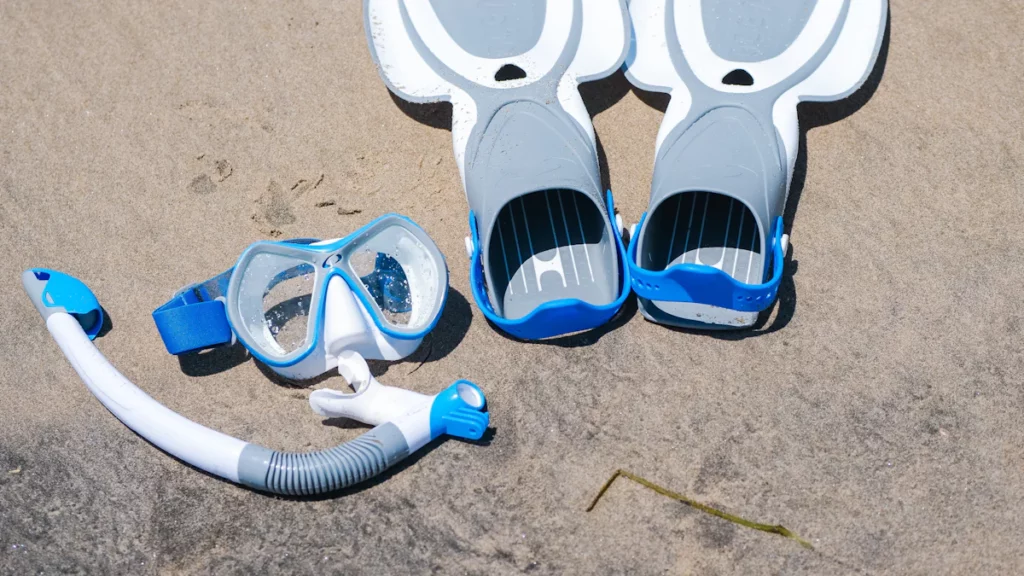
Utiliser correctement ses palmes de snorkeling peut considérablement améliorer votre expérience sous-marine en améliorant la propulsion et en réduisant la fatigue. Voici un guide étape par étape pour vous aider à tirer le meilleur parti de vos palmes :
Étape 1 : Choisissez les bonnes palmes
- Sélectionnez le type : Choisissez entre des palmes à pied complet ou à talon ouvert en fonction de votre lieu de plongée et de la température de l'eau.
- Vérifiez l'ajustement : Assurez-vous que vos palmes soient bien ajustées et confortables. Elles ne doivent ni pincer ni glisser.
- Test de confort : Marchez un peu pour vous assurer qu’il n’y a pas de points de pression ou d’inconfort.
Étape 2 : Mettez vos palmes
- Palmes chaussantes : Faites simplement glisser vos pieds dans les palmes, en vous assurant qu'elles s'adaptent parfaitement à vos pieds.
- Palmes à talon ouvert : Enfilez des chaussons en néoprène si vous en utilisez. Glissez votre pied dans la palme et ajustez les sangles jusqu'à ce qu'elles soient bien ajustées, mais pas trop serrées.
Étape 3 : Entrez dans l'eau
- Eaux peu profondes : Enfilez vos palmes assis au bord de l'eau. Glissez doucement dans l'eau pour éviter d'abîmer vos palmes.
- Eaux profondes : Entrez dans l'eau sans palmes, puis enfilez-les en flottant sur le dos. Faites-vous aider d'un binôme si nécessaire.
Étape 4 : Maîtriser la technique des coups de pied
- Coup de pied flottant : Effectuez un battement de jambes lent et régulier à partir des hanches, en gardant les jambes relativement droites. Évitez de trop plier les genoux.
- Mouvements fluides : Privilégiez des mouvements fluides et contrôlés. Des coups de pied rapides et puissants peuvent vite vous fatiguer et réduire votre efficacité.
- Pratique: Passez du temps à pratiquer votre coup de pied dans des eaux calmes et peu profondes pour développer votre confiance et votre technique.
Étape 5 : Naviguez efficacement
- Gardez votre corps horizontal : Maintenez une position horizontale pour réduire la traînée et vous déplacer plus efficacement.
- Utilisez vos bras : Combinez des coups de palmes avec des mouvements de bras doux pour diriger et maintenir l'équilibre.
- Restez détendu : Gardez vos mouvements fluides et détendus pour conserver votre énergie et profiter de l'expérience.
Étape 6 : Entretien et maintenance
- Rincer après utilisation : Rincez toujours vos palmes à l’eau douce après chaque utilisation pour éliminer le sel, le sable et autres débris.
- Bien sécher : Laissez vos palmes sécher à l’air libre dans un endroit frais et ombragé, à l’abri de la lumière directe du soleil.
- Stocker correctement : Rangez vos palmes dans un endroit frais et sec, en évitant de poser des objets lourds dessus pour éviter qu'elles ne se déforment.
Comment choisir les bonnes palmes de snorkeling ? 3 facteurs à prendre en compte
Pour choisir de bonnes palmes de snorkeling, il est essentiel de faire le bon choix pour une expérience sous-marine confortable et agréable. Comprendre les facteurs clés peut vous aider à trouver les palmes qui correspondent à vos besoins. Voici trois points essentiels à prendre en compte :
Ajustement et confort
Une paire de palmes bien ajustée, confortable et bien ajustée est primordiale. Des palmes mal ajustées peuvent provoquer des ampoules, des crampes, voire gâcher votre aventure de snorkeling. Veillez donc à ce que vos palmes soient bien ajustées à vos pieds, sans être trop serrées.
Talon fermé vs. talon ouvert
Lors du choix de palmes de snorkeling, il est essentiel de choisir entre un modèle à talon fermé ou ouvert. Les palmes à talon fermé offrent un ajustement sûr en enveloppant entièrement le pied, assurant stabilité et propulsion lors de vos explorations sous-marines. Les palmes à talon ouvert, quant à elles, sont dotées d'une sangle réglable pour un ajustement personnalisé, idéales pour la plongée sous-marine dans différentes températures et sur différents terrains.
Importance d'un ajustement parfait
Choisir des palmes de snorkeling bien ajustées est primordial pour une expérience aquatique optimale. Une palme bien ajustée évite les glissements et l'inconfort lors de vos sorties snorkeling, vous permettant de vous déplacer sans effort avec un contrôle et une précision accrus.
Utilisation prévue
- Natation longue distance : Pour les plongeurs débutants qui se lancent dans des excursions de nage longue distance, choisir la bonne paire de palmes est crucial. Optez pour des palmes offrant une propulsion efficace et un confort optimal sur de longues périodes, vous permettant de parcourir de plus grandes distances avec moins d'effort. Un choix judicieux de palmes peut faire une différence significative sur votre endurance et votre plaisir lors de longues séances de snorkeling.
- Eaux calmes : Pour explorer des eaux calmes ou pratiquer la plongée en apnée tranquillement, privilégiez des palmes offrant une maniabilité sans force excessive. Conçues pour les eaux calmes, les palmes offrent une poussée douce, vous permettant de naviguer dans des environnements sous-marins sereins avec aisance et grâce. Choisir des palmes adaptées aux conditions de l'eau garantit une expérience de plongée fluide et relaxante.
Marques populaires
Un bon fabricant de palmes de plongée en apnée fournit souvent un service personnalisé et une solution unique pour chaque client, vous pouvez donc acheter des palmes de marques de palmes de plongée en apnée célèbres.
Avant-garde
Avant-garde Vanguard est une marque réputée pour ses designs innovants et ses palmes de snorkeling de haute qualité. Axée sur la performance et la durabilité, Vanguard propose une gamme de palmes adaptées aux débutants comme aux passionnés expérimentés. Explorez la sélection variée de palmes Vanguard pour trouver celle qui vous convient le mieux pour vos explorations sous-marines.
plongeurs américains
US Divers s'est imposé comme une référence dans le monde du matériel de snorkeling, notamment grâce à ses palmes haut de gamme. Réputées pour leur fiabilité et leur fonctionnalité, les palmes US Divers s'adaptent à tous les niveaux et préférences, garantissant confort, efficacité et style lors de vos sorties snorkeling dans différents environnements marins.
Juments
Mares se distingue par sa technologie de pointe et son design ergonomique pour sa gamme de palmes de snorkeling. Que vous recherchiez des performances supérieures ou un confort exceptionnel, les modèles de palmes innovants Mares répondent à ces deux critères. Vivez des expériences sous-marines inégalées grâce au savoir-faire reconnu et au souci du détail de Mares.
Amika par Aqualung
Amika by Aqualung allie style et fonctionnalité dans sa collection de palmes de snorkeling haut de gamme. Conçues pour les personnes axées sur la performance et recherchant à la fois esthétique et efficacité, les palmes Amika allient design moderne et fonctionnalités avancées. Sublimez vos aventures de snorkeling avec les palmes à la fois sophistiquées et pratiques d'Amika by Aqualung.
Comment entretenir les palmes de snorkeling ?
Pour que vos palmes de snorkeling restent en parfait état lors de vos aventures sous-marines, un entretien adéquat est essentiel. Voici quelques conseils pratiques pour entretenir vos palmes et prolonger leur durée de vie :
- Rincer après utilisation:Après chaque séance de plongée en apnée, rincez soigneusement vos palmes à l'eau douce pour éliminer le sel, le sable et les débris qui peuvent causer des dommages au fil du temps.
- Bien sécherLaissez vos palmes sécher complètement à l'air libre avant de les ranger pour éviter la formation de moisissures. Rangez-les dans un endroit frais et sec, à l'abri de la lumière directe du soleil.
- Inspecter régulièrementVérifiez que vos palmes ne présentent aucun signe d'usure, comme des fissures ou des sangles desserrées. Résolvez tout problème rapidement pour éviter d'aggraver les dommages.
- Évitez les températures extrêmes:N'exposez pas vos palmes à une chaleur ou un froid extrême, car cela peut affaiblir les matériaux et affecter leurs performances.
- Stocker correctement:Lorsque vous ne les utilisez pas, rangez vos palmes à plat ou suspendues pour conserver leur forme et éviter qu'elles ne se déforment.
Conclusion
En résumé, comprendre ce que sont les palmes de snorkeling est essentiel pour améliorer votre expérience sous-marine. Ces palmes existent en différents modèles, chacun conçu pour s'adapter à différentes conditions et préférences. Que vous optiez pour des palmes chaussantes pour leur simplicité et leur confort, des palmes à talon ouvert pour leur polyvalence ou des palmes fendues pour leur efficacité, choisir la bonne paire est crucial. N'oubliez pas de prendre en compte des facteurs tels que l'ajustement, le confort et l'utilisation prévue pour faire un choix éclairé. Avec des palmes de snorkeling adaptées, vous glisserez sans effort dans l'eau, économiserez votre énergie et profiterez de la beauté du monde sous-marin.
FAQ
Q1 : Comment choisir la bonne taille de palmes de snorkeling ?
Choisir la bonne taille de palmes de snorkeling implique de les essayer pour vérifier qu'elles sont bien ajustées et sans pincement. Si vous achetez en ligne, consultez le tableau des tailles du fabricant et lisez les avis pour vérifier la précision de l'ajustement. Assurez-vous qu'il y ait suffisamment d'espace pour bouger les orteils sans que les palmes ne glissent.
Q2 : Puis-je utiliser mes palmes de snorkeling pour la plongée sous-marine ?
Oui, vous pouvez utiliser des palmes de snorkeling pour la plongée sous-marine, surtout si elles offrent une propulsion adéquate. Cependant, les palmes de plongée sont généralement plus rigides et plus robustes, conçues pour les plongées plus profondes et les courants forts. Réfléchissez au type de plongée que vous pratiquerez pour vous assurer que vos palmes sont adaptées.
Q3 : À quel point les palmes de plongée en apnée doivent-elles être serrées ?
Les palmes de snorkeling doivent être bien ajustées, mais pas trop serrées. Elles doivent maintenir fermement votre pied sans gêner ni gêner la circulation. Vous devez pouvoir bouger vos orteils et éviter tout point de pression excessif ou glissement lors de vos mouvements.
Q4 : Ai-je besoin de chaussons avec palmes chaussantes ?
En général, les chaussons ne sont pas nécessaires avec les palmes chaussantes, car elles sont conçues pour être portées pieds nus. Cependant, certains plongeurs préfèrent porter des chaussettes fines en néoprène pour plus de confort et éviter les irritations, surtout s'ils pratiquent la plongée pendant de longues périodes.
Q5 : Comment puis-je éviter les ampoules causées par les palmes de plongée ?
Pour éviter les ampoules, assurez-vous que vos palmes sont bien ajustées. Porter des chaussettes ou appliquer un lubrifiant sur les zones sujettes aux frottements peut également aider. Adaptez progressivement vos nouvelles palmes en réduisant les séances de snorkeling et évitez de trop serrer les sangles des palmes à talon ouvert.
